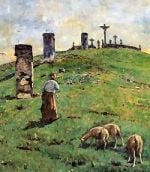Our Lady of Guadalupe
by Zsolt Aradi
The story of the Shrine of Our Lady of Guadalupe falls in the same period of Spanish history as that of Covadonga. When Don Rodrigo, the leader of the Visigoths, was defeated by the Saracens in 711 and his people fled to the mountains, some of the knights on their way to Asturia took with them a statue of the Blessed Virgin. This statue, which had been given to Bishop Leander of Seville by Pope Gregory the Great, was cherished not only by the great churchman Leander and the people of Seville, but it had special significance in that it came from the Pope himself. The armies of the Saracens seemed invincible; nevertheless the defending Christians, heedless of their own lives, fought on during their retreat; but they were very much concerned over such treasures as the image of Our Lady. Faced with the threat of annihilation, they wanted to secure the statue of Our Lady. So they placed the statue in an iron casket and buried it somewhere in a cave of the province of Estremadura, close to the Asturian Mountains, in the northern part of Spain.
Those who carried the image to safety died in battle and through the centuries no one was aware that an image of the Madonna, cherished by a great Pope and a great Bishop of Seville, was buried somewhere in the soil of Spain. Meanwhile, the Moorish rule established itself on the Iberian Peninsula. Christianity was not oppressed but was subjected to much hardship. Moors, Visigoths, and Hispanic tribes mixed and created a unique cultural pattern under Islamic rule. The forces of Western Christianity, however, were on the move; the cities of Spain were recaptured one by one and the country was liberated. The rule of the Saracens lasted for over four hundred years in Spain.
After the liberation, the country did not forget the promises made by its leaders to the Blessed Virgin. Great pilgrimages visited the sanctuaries of Covadonga, of Saragossa, and the many others. The cult of the Madonna grew in intensity with each passing year. Anything that was connected with her had the greatest significance and this enthusiasm did not wane with the passage of time.
In 1326, Spain was already an established power. Still the whole nation lived literally under the protection of Our Lady because she became part of the nation's and everybody's life. It is quite understandable that in 1326, when a humble cowherd named Gil, from Estremadura, reported that Our Lady had manifested herself to him, and that he had found a casket buried in the earth, the announcement evoked great emotion. When ecclesiastical authorities reached the little village of Guadalupe in the neighborhood where the casket had been unearthed, they discovered that it contained a statue, which had been concealed six hundred years before by the Knights of Don Rodrigo during their flight. Pertinent documents vouchsafed for the authenticity of the image. The statue, though buried beneath the earth for six hundred years, was perfectly preserved.
So the shrine came into existence at Guadalupe. The image was entrusted to the custody of the Franciscan fathers and Our Lady of Guadalupe became one of the most important pilgrim places of Spain. From 1326 on, throughout the centuries that followed and until the present, Guadalupe has never lost its importance. The veneration of Our Lady of Guadalupe was at its height during the great discoveries. Columbus, and later the conquistadors, carried a replica of the image with them on their journeys, and the Franciscans who accompanied these men to do missionary work in the newly occupied countries, particularly in Mexico, spread the veneration of the "Virgen" of Guadalupe wherever they went. This inspired the Franciscans, and among them the first Bishop of Mexico, Zumaraga, to name the new shrine after the apparitions on the hill of Tepeyac in honor of the Virgin of Guadalupe, Spain. The new Guadalupe in Mexico was to outgrow, in importance, its prototype.
The original image of Our Lady of Guadalupe in Spain has distinctive mixed Moorish and Spanish characteristics. It is interesting to note that the name Guadalupe--where the casket and the image had been found--is also a mixed Spanish-Arab word meaning River of the Wolf, because Estremadura for centuries--particularly during the Middle Ages --was infested with wolves. The Franciscan convent in Guadalupe and its chapel, built after the discovery of the statue which was placed there, are works of Moorish masons converted to Christianity. The convent is one of the most interesting specimens of mixed Moorish-Gothic art in Spain.
Despite its great fame, the Guadalupe shrine has an atmosphere of tranquility. Guadalupe itself is still a hamlet and the Lady of Guadalupe, though one of the most venerated on the Iberian Peninsula and known as the Powerful Lady, to whom kings and conquistadors came to express their gratitude, is known to the common people as Our Lady of Silence.
This item 2991 digitally provided courtesy of CatholicCulture.org






